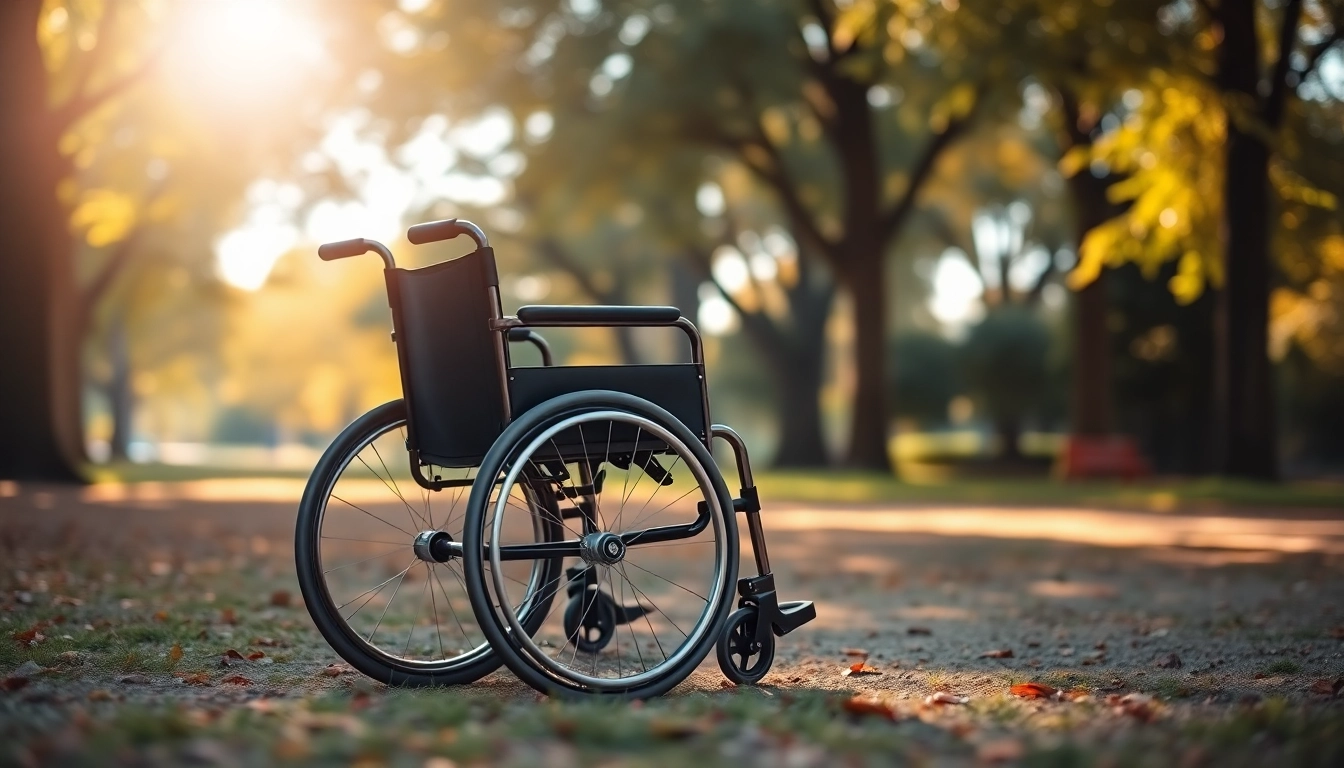Understanding Manual Wheelchairs
What is a Manual Wheelchair?
A manual wheelchair is a mobility device propelled by the user or an attendant, offering independence and accessibility to individuals with limited mobility. These wheelchairs are designed to assist those who may have difficulty walking due to various impairments, including disabilities resulting from injury, illness, or aging. Unlike powered wheelchairs, manual wheelchairs require physical engagement from the user, promoting not only mobility but also exercise and physical health.
How Manual Wheelchairs Work
Manual wheelchairs operate through a simple mechanism: the user propels themselves forward by pushing the large rear wheels with their hands. These wheels are designed for easy gripping and efficiency, allowing users to navigate various terrains. Most models include front casters for stability and steering, while the armrests and footrests are adjustable to ensure comfort and easy access.
Benefits of Using a Manual Wheelchair
Utilizing a manual wheelchair offers numerous advantages. First, they are often more affordable than powered models, making them accessible for a broader range of users. Additionally, they tend to be lighter and more portable, which is ideal for travel and storage. Manual wheelchairs also permit the user to engage in physical activity, thereby supporting overall health. They can improve upper body strength and stamina while granting users the independence to navigate different environments.
Choosing the Right Manual Wheelchair
Key Features to Consider
When selecting a manual wheelchair, several features play a pivotal role in ensuring that the chair meets the needs of the user. Key features include:
- Weight: Lighter wheelchairs are easier to maneuver and transport, making them ideal for users needing to lift their wheelchair into vehicles.
- Frame Type: Aluminum frames are strong and lightweight, while steel frames provide durability at a heavier weight. Understanding the balance between weight and sturdiness is essential.
- Wheel Size: Larger wheels can navigate over obstacles more easily, while smaller wheels enhance maneuverability in tight spaces.
- Seat Width and Depth: Customizing the seat dimensions to fit the user’s body can enhance comfort and support, preventing issues such as pressure sores.
- Footrests and Armrests: Look for adjustable or removable options that suit the user’s individual needs.
Types of Manual Wheelchairs
There are several types of manual wheelchairs available, each designed for specific user needs and conditions:
- Standard Wheelchairs: Designed for everyday use, these are generally robust and come with a variety of features to provide comfort and functionality.
- Lightweight Wheelchairs: Often made from aluminum, these are great for those who require a wheelchair primarily for occasional use and who value portability.
- Transport Wheelchairs: These are ultra-light and designed primarily for being pushed by a caregiver, ideal for those who do not self-propel.
- All-Terrain Wheelchairs: Equipped with large, rugged wheels, these allow users to explore bumpy terrain and outdoor environments effectively.
- Custom Wheelchairs: Tailored to meet specific medical needs or personal preferences, these can include specialized seat dimensions and additional supports.
Assessing User Needs and Lifestyle
Choosing the right manual wheelchair is not just about features; it is equally essential to evaluate the user’s lifestyle and specific needs. Consider the following:
- Physical Condition: Assess the user’s strength and capability to propel the wheelchair. Those with upper body weakness may require a lighter model or additional support.
- Living Environment: Evaluate the types of surfaces the wheelchair will navigate, such as rough terrain or indoor spaces. This can guide the choice of wheel size and type.
- Daily Activities: Consider how the user intends to use the wheelchair. Will it primarily be for short trips or longer outings? This determination can influence the choice between transport versus standard models.
- Customization: Some users may need specialized features tailored to medical needs like cushions for pressure relief or supportive backrests.
Best Practices for Manual Wheelchair Maintenance
Regular Checks and Maintenance Tips
Proper maintenance is key to ensuring a manual wheelchair remains functional and safe for the user. Regular checks should include:
- Inspecting Wheels: Regularly check for signs of wear and tear, including proper inflation (for pneumatic tires) and ensuring spokes are intact.
- Lubricating Moving Parts: Use silicone-based lubricants on wheel bearings and other moving parts to maintain smooth operation.
- Checking Brakes: Ensure brakes are functioning properly to prevent accidents. Adjust or replace them if necessary.
- Cleaning: Keep the wheelchair clean and free of debris. Use appropriate cleaning solutions that do not harm the materials.
Common Repairs for Manual Wheelchairs
Even with regular maintenance, some repairs may become necessary. Common issues include:
- Flat Tires: If a tire is flat, assess whether it can be repaired or if a replacement is necessary.
- Brake Malfunctions: These can often be fixed by tightening or adjusting brake cables, but replacement may be required if the issue persists.
- Loose or Worn Down Parts: Regularly inspect screws and components to maintain safety; replace any that are damaged or loose.
Maintaining Comfort and Usability
Beyond mechanical maintenance, user comfort is paramount. Consider factors such as:
- Cushioning: Invest in good quality seat and back cushions to prevent discomfort and pressure sores.
- Adjustability: Ensure arm and leg rests are adjustable to promote comfort based on individual needs.
- Establishing a Routine: Create a maintenance schedule to regularly check the wheelchair condition and adapt user settings as necessary.
Using a Manual Wheelchair: Tips for Daily Life
Navigating Different Environments
Utilizing a manual wheelchair effectively requires skill and awareness of surroundings. Here are some strategies:
- Plan Routes: Always assess routes ahead of time for accessibility, noting any ramps, steps, or uneven surfaces.
- Use Proper Techniques: Practice maneuvers like turning, going uphill, and descending slopes to ensure safety and efficiency.
- Seek Assistance: In crowded or complicated environments, do not hesitate to ask for help when needed.
Techniques for Safe Mobility
Safety is paramount when using a manual wheelchair. Employ these techniques:
- Braking: Always engage the brakes when stationary to prevent slipping and sliding.
- Center of Gravity: Lean slightly forward while navigating inclines to maintain balance and avoid tipping.
- Attendant Strategies: Caregivers should learn proper lifting techniques to prevent injury when assisting users.
Adapting to Life with a Manual Wheelchair
Transitioning to life with a manual wheelchair can be challenging. Here are some tips for adaptation:
- Physical Therapy: Engage in therapy to optimize strength and functional abilities relevant to using the wheelchair.
- Community Engagement: Participate in groups or forums for shared experiences and advice, which can greatly assist in acclimating to new lifestyles.
- Personal Mobility Goals: Set realistic goals for mobility that motivate the user to improve skills and confidence.
Future of Manual Wheelchairs
Innovations in Manual Wheelchair Design
The world of manual wheelchairs is evolving, marked by innovative designs and technological advancements. Key trends include:
- Ergonomic Designs: Modern chairs emphasize ergonomics to improve comfort and reduce strain during use.
- Lightweight Materials: Advancements in materials technology, such as carbon fiber, offer lighter and stronger alternatives, enhancing transportability.
- Customizability: Increasing options for personalization—like varying seat heights, widths, and additional supports—are being integrated into new designs.
Community Resources and Support
Support is critical for users of manual wheelchairs. Here are resources to explore:
- Local Support Groups: Many communities have groups where individuals can learn from each other, share experiences, and join social events.
- Educational Programs: Workshops or classes on wheelchair skills and maintenance can enhance user independence and knowledge.
- Online Forums: Various online platforms provide a wealth of information and a space to connect with others facing similar challenges.
Trends in Accessibility and Mobility
The future also points toward increased efforts for accessibility in public areas, as well as advancements in infrastructure to support mobility devices like manual wheelchairs. Trends include:
- Smart Technology: Integration of smart technology in wheelchairs that allow for navigation assistance and activity tracking.
- Improved Public Spaces: Ongoing initiatives are aiming to enhance accessibility in both urban and rural settings, ensuring all individuals can navigate their environments safely and comfortably.



